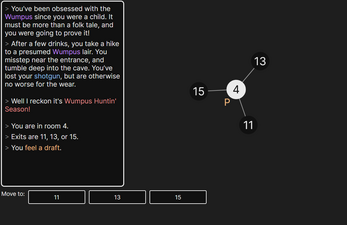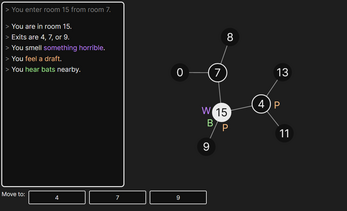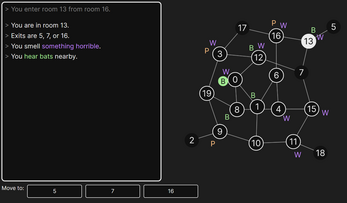Wumpus Wump You
Wumpus Wump You
A proof-of-concept for a randomized game with an undirected graph. I'm considering taking this game in a couple different directions, but I think this engine is a good base. I'm happy with the auto-mapping and how extensible this format could be. Might take some iteration!
In it's current form, it is very much just Hunt the Wumpus, but I hadn't seen a nice implementation of the non-grid Wumpus (especially with automapping)!
Controls
- Click and drag map background to pan
- Scrollwheel on map to zoom in and out
- Click and drag map nodes to rearrange them
- Click buttons to do actions!
- Shift+click or double click nodes to lock them in place
- Shift+R to start a new game
Tips
- You can hear bats from 1 room away.
- You can feel a draft from a pit 1 room away.
- You can smell the Wumpus from 2 rooms away.
- Use deductive reasoning to minimize risk!
| Status | In development |
| Platforms | HTML5 |
| Rating | Rated 4.7 out of 5 stars (18 total ratings) |
| Author | gate |
| Genre | Puzzle, Strategy |
| Tags | Exploration, Horror, hunt-the-wumpus, Retro, Roguelike, Short, Text based, wumpus |
| Average session | A few minutes |
| Languages | English |
| Inputs | Keyboard, Mouse |
| Accessibility | High-contrast |
Development log
- v0.0.3 UpdateMay 02, 2021
- v0.0.2 UpdateApr 30, 2021



Comments
Log in with itch.io to leave a comment.
I encountered a missing map marker error
I suspect it had something to do with the anti-first turn spawn kill by the wumpus interacting with running into bats first turn.
I hope the screenshots are helpful.
I encountered the missing marker issue again and it definitely is related to hitting the bats.
I also noticed a strange behavior with the elastic nodes for letters sharing a circle. If you grab a bat or pit marker, the wumpus marks are unperturbed, but if you grab a wumpus marker, the bat or pit markers follow them a little.
I’d like to amend that strange stretch behavior to note the behavior in a triple marker situation. When it is solid circles, the wumpus marker drags both, the bat marker drags the pit, and the pit marker drags none. For the letter markers (adjacent to room clues), the W drags both P and B, the P drags the B but not the W, and the B drags neither W or P. Some sort of non-reciprocal elasticity is occurring.
hey thanks for the detailed bug reports -- i'm currently wrapping up another game so i haven't had time to figure out what's going on but these will be useful in the future!
If you do get back to this, a seed feature to share maps would be excellent! I’d love to be able to save tricky seeds so I had a stash of hard maps I lost at for a rainy day!
Another feature recommendation I would add besides autocollecting shotgun and shell and being able to mark rooms with hazard colors or icons, is a number of rooms visited, seen, and unseen remaining. The number of times I have counted rooms because I am not sure if I missed a collect prompt or haven’t found an isolated branch is too high.
(And there are the occasional few edge cases where knowing the number of rooms remaining makes it easier to spot a trap situation!)
One more bug report, since I happened to screenshot it on the first turn!
Interesting take on an very old classic. For those wondering about the full ruleset, you need to find the shotgun and the shotgun shell first, move adjacent to the wumpus room, load the shotgun, and select the wumpus lair.
Sometimes you have to enter a bat room on purpose to get out of a stuck situation, but hazard markers don’t appear if you don’t get the white ring around the bat room.
The two pits, the two bats, and the wumpus lair can overlap. The shotgun shell and shotgun cannot be in a room with a hazard but they can be isolated by hazards requiring a bat gamble to enter the isolated branch.
Maps can be impossible or not deducible because the layout doesn’t allow more information to be gained. Unless you are restart scumming for safer maps, you should expect to lose about 1 in 6 times about 2/5ths from unwinnable/losing a forced gamble maps, and 3/5ths getting ganked right after spawn. This one, I had no shotgun or shell, or bats to gamble with, so I was trapped.
I wish I could place markers or colors on where I thought pits, bats, and the wumpus were. It would also be helpful to autocollect the shotgun and shell. Usually I am focused on the map, so I’ve missed the collect prompt.
This is one of my favorite terminal games. Glad to see this as a smooth browser game, good job!
i'm obsessed with this game. 10/10; would recommend
:)
I love how elastic the moving the map feels. Once I figured out the puzzle (I missed the tips section) I just started moving around the mess that was my map. It has the right amount of elastic to respond to what I want and rigid enough to keep the other side in place
Yeah, definitely had to fiddle with the exact numbers a lot, but the heavy lifting is done by the d3(-force) library. Check it out if you're a JS dev! https://github.com/d3/d3-force
These elastic balls aren't that difficult to program. I do this all the time. After playing World of Goo, I reprogrammed the core gameplay in at least 5 languages/engines.
Basically you just need to do this for every connection:
fn apply_connection_force(ball1: &mut Ball, ball2: &mut Ball, goal_distance: f32, force_factor: f32) {
let diff = ball2.pos - ball1.pos;
let dis = diff.magnitude();
let dir = diff / dis;
let force = dir * (dis - goal_distance) * force_factor;
ball1.vel += force;
ball2.vel -= force;
}